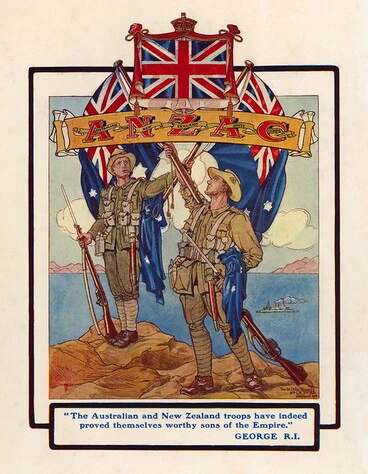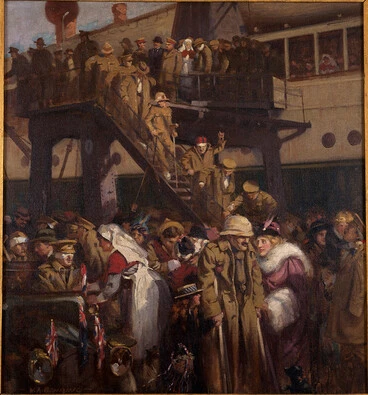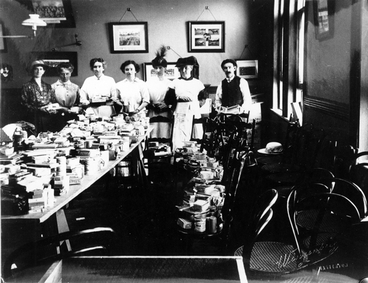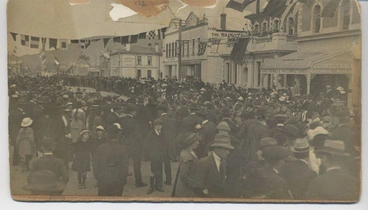Anzac Day
A DigitalNZ Story by Heather Scullion
The Story of the the Anzacs and New Zealand's experience of the First World War in photographs.
The March to War - 1914.
The Declaration of War August 1914.
Britain declared war on Germany on the 4th of August 1914. This was a result of Germany's refusal to remove troops from neutral Belgium and to heed Britain's ultimatum for them to withdraw. New Zealand was informed the next day and the Governor, Lord Liverpool announced the news from the steps of Parliament in Wellington. Britain's declaration was on behalf of its entire Empire including the Dominion of New Zealand and thus no separate declaration of war by New Zealand was needed. Ties to Britain were strong and despite its small size and geographic isolation the New Zealand Government announced that it too was at war with Germany and followed Britain into the war.
Mobilisation and the New Zealand Expeditionary Force.
The Government authorised the organisation of an Expeditionary Force for war service abroad. Mobilisation of the force occurred swiftly and by September 1914 the NZEF consisted of two main divisions - The New Zealand Infantry Brigade and The New Zealand Mounted Rifles Brigade. As early as October 1914, the main body of the force sailed from Wellington. The NZEF was diverted from landing in Europe and was then landed in Egypt. Whilst in Egypt the NZEF joined with the Australian Imperial Force (AIF) to form the Australian and New Zealand Army Corps (ANZAC).
Training and Marching to Wellington
Between 1915-1918 60,000 soldiers trained at the Featherston Military Camp in Featherston. They marched over the 555 metre pass to the Trentham Army Camp before embarking for the front at Wellington docks.
Sad Farewells
Between 1914-1916 over 100,000 men were farewelled to war. Troops were gathered from all over New Zealand and large crowds watched as they were sent off.
From then on loved ones waited anxiously for news from their sons, husbands and brothers.
The Troopship Journey
The ships were crowded with men, horses, ships' crew and supplies. The journey lasted 48 days and the troops were kept busy with training, target practice and lectures. Conditions on board were tough.
Politicians and a crowd, outside Parliament Buildings, upon the declaration of war with Germany. Ref: 1/2-045239-G. Alex
Politicians and a crowd, outside Parliament Buildings, upon the declaration of war with Germany
Alexander Turnbull Library
New Zealand's volunteer army
Auckland Libraries
https://masterton.spydus.co.nz/cgi-bin/spydus.exe/MSGTRNGEN/WPAC/PICTUREWAIRARAPA?HOMEPRMS=PICQUICKPARAMS
Seventh Reinforcement marching over the Rimutaka Hill : digital image
Wairarapa Archive
The image is from the “Anzac Book”, written and illustrated by the men who served at Gallipoli, and published in 1916.
ANZAC
Archives New Zealand Te Rua Mahara o te Kāwanatanga
Maori Pioneer Battalion aboard ship before their departure. Ref: 1/2-091150-F. Alexander Turnbull Library, Wellington, N
Maori Pioneer Battalion aboard ship before their departure
Alexander Turnbull Library
Theatres of War.
New Zealand soldiers served in many theatres of war including Samoa, Gallipoli, Palestine, Belgium and France.
New Zealand and Australian soldiers landing at Anzac Cove, Gallipoli, Turkey. New Zealand Free Lance : Photographic prin
New Zealand and Australian soldiers landing at Anzac Cove, Gallipoli, Turkey
Alexander Turnbull Library
Landing at Anzac Cove, Gallipoli. Ref: PAColl-0063-03. Alexander Turnbull Library, Wellington, New Zealand. /records/226
Landing at Anzac Cove, Gallipoli
Alexander Turnbull Library
Egypt, World War I. McAllister, James, 1869-1952 :Negatives of Stratford and Taranaki district. Ref: 1/1-012536-G. Alexa
Egypt, World War I
Alexander Turnbull Library
Maori Pioneers await their evening meal on the Somme. Royal New Zealand Returned and Services' Association :New Zealand
Maori Pioneers await their evening meal on the Somme
Alexander Turnbull Library
News from home in the front line trenches, World War I. Royal New Zealand Returned and Services' Association :New Zealan
News from home in the front line trenches, World War I
Alexander Turnbull Library
Sergeant Paddy the canine mascot, wearing a coat with his name and sergeant's stripes on it, looks around at the inspect
Sergeant Paddy
Archives New Zealand Te Rua Mahara o te Kāwanatanga
When casualties mounted at Gallipoli, the New Zealand government ordered a hospital ship. With the help of a huge public
Departure of the Hospital Ship "Maheno", 1915
Archives New Zealand Te Rua Mahara o te Kāwanatanga
New Zealand troops landing in Samoa. Ref: 1/4-017532-F. Alexander Turnbull Library, Wellington, New Zealand. /records/22
New Zealand troops landing in Samoa
Alexander Turnbull Library
Front-line trench, Somme salient, France', from An Encyclopaedia of New Zealand, edited by A. H. McLintock, originally p
Front-line trench, Somme salient, France
Manatū Taonga, the Ministry for Culture and Heritage
https://masterton.spydus.co.nz/cgi-bin/spydus.exe/MSGTRNGEN/WPAC/PICTUREWAIRARAPA?HOMEPRMS=PICQUICKPARAMS
The Commander-in-Chief reviews the New Zealanders, postcard : digital image
Wairarapa Archive
On 9 January 1916, the eight month long Gallipoli Campaign finally ended with the evacuation of the last British troops
'The Homecoming from Gallipoli', 15 July 1915 by Walter Armiger Bowring
Archives New Zealand Te Rua Mahara o te Kāwanatanga
Women at War 1914-1920
Women were involved in the War effort from the very beginning. New Zealand Nurses and Doctors went overseas to assist sick and wounded soldiers in all the theatres of war. They drove ambulances, managed hospitals and convalescent homes. Women were involved in various aspects of the war effort, such as the production of textiles and clothing, helped to organise mobilisation, aided repatriation of soldiers and were involved in enormous amounts of both volunteer and paid work.
'Her Excellency's Knitting Book' appeared in August 1915. This 193-page book, produced by the Governor General's wife, L
Knitting pattern book, 'Her Excellency's Knitting Book'
Museum of New Zealand Te Papa Tongarewa
Accession Description: Photograph Album of 22/318 Staff Nurse Elfrida Anne Parkinson. The album covers a hospital somewh
WWI Photograph Album
National Army Museum
https://masterton.spydus.co.nz/cgi-bin/spydus.exe/MSGTRNGEN/WPAC/PICTUREWAIRARAPA?HOMEPRMS=PICQUICKPARAMS
Sending comfort items to the New Zealand troops in Gallipoli
Wairarapa Archive
Civilian women inside a supply depot during World War I. Ref: 1/1-008352-G. Alexander Turnbull Library, Wellington, New
Civilian women inside a supply depot during World War I
Alexander Turnbull Library
http://www.aucklandcity.govt.nz/dbtw-wpd/HeritageImages/termsofuse.htm
Making paper into cloth: a new industry created by the war
Auckland Libraries
Returning to NZ, repatriation, rehabiliation and commemorating the Anzacs.
First ANZAC Day Observance, Petone Railway Station, 25 April 1916 #ANZAC
Archives New Zealand Te Rua Mahara o te Kāwanatanga
Return of the Pioneer (Māori) Battalion, 1919
Manatū Taonga, the Ministry for Culture and Heritage
Women selling ANZAC poppies, Wellington
Alexander Turnbull Library
'Soldier's repatriation guide', URL: https://nzhistory.govt.nz/media/photo/soldiers-guide, (Ministry for Culture and Her
Manatū Taonga, the Ministry for Culture and Heritage
WWI Armistice Celebrations
Waimate Museum and Archives
Presumed to be a procession to mark the end of World War I (WWI), showing the corner of The Square and Coleman Place. Th
Palmerston North City Library















